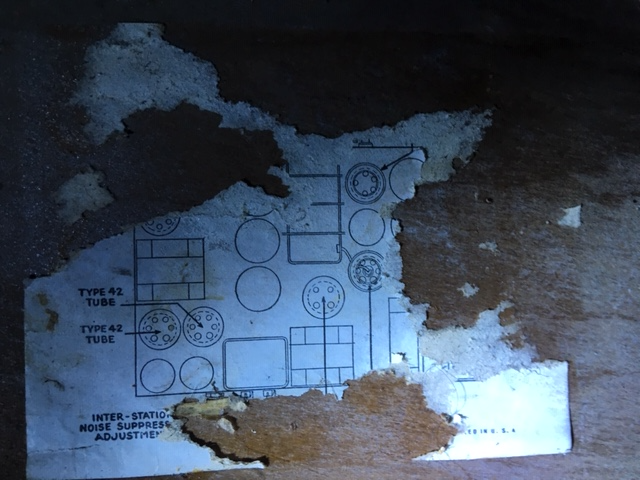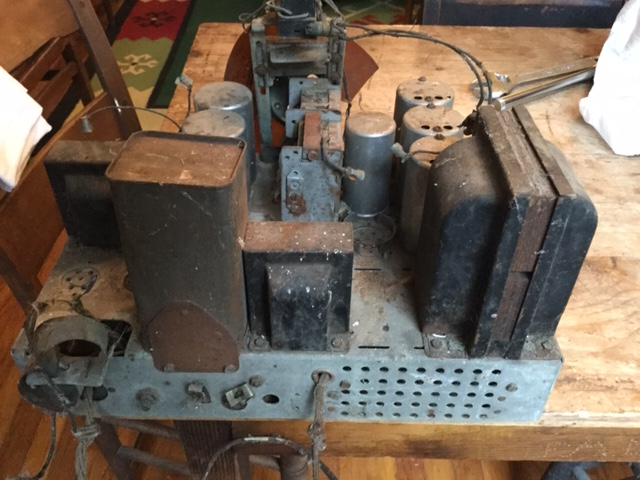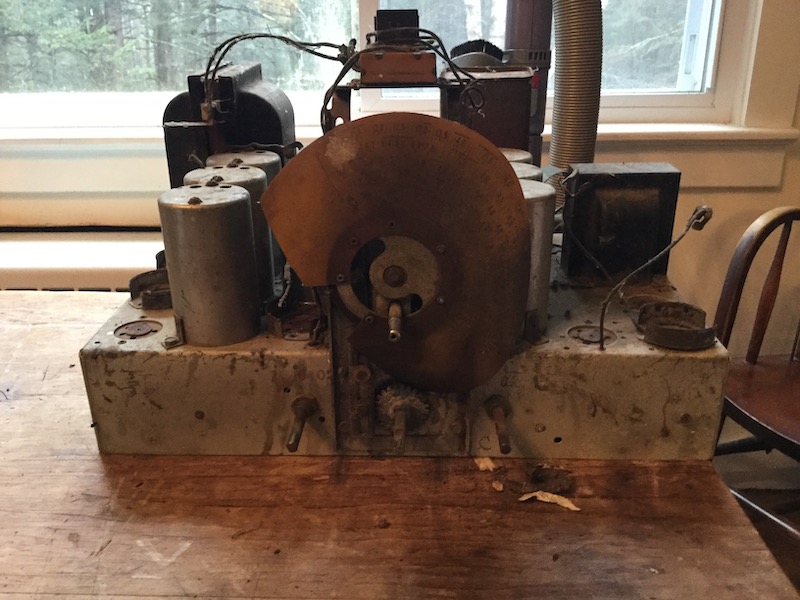Posts: 23
Threads: 2
Joined: Dec 2018
City: New York
State, Province, Country: New York
Hi — I pulled what appears to be a 17b out of the attic a while back. Chassis rough, cabinet even rougher. (This set was an antique when I was in the high school radio club 45 years ago.).
After lurking here for a couple of weeks, downloading some schematics, and refreshing my memory as to what a superheat receiver is, now I have some total newbie questions:
How do I know what a “Type 42” tube (for example) is?
In a cardboard box I found a Cunningham CX-326 and National Union NX-171A and some te others, what “type(s)” are these?
Posts: 15,301
Threads: 532
Joined: Oct 2011
City: Jackson, NJ
https://www.radiomuseum.org/tubes/tube_42.html
42 s a power pentode.
Just type the tube type with the wod "tube" in google and you will have your answers.
Welcome.
People who do not drink, do not smoke, do not eat red meat will one day feel really stupid lying there and dying from nothing.
(This post was last modified: 12-20-2018, 09:38 AM by morzh.)
Posts: 5,005
Threads: 267
Joined: Nov 2012
City: Bandon
State, Province, Country: OR
Welcome to the Phorum!

Tubes are identified by numbers and letters. At morzh said, a 42 is a power pentode. An 80 is a full wave rectifier. specifications for tubes can be found in a number of online places. I like to use the N7JPDatabase: http://www.nj7p.info/
Click on Tube SQL Database, then enter the tube number you want to lookup and click on LOOKUP. For example here's the 42 tube info: http://www.nj7p.info/Tubes/SQL/Tube_query.php?Type=42
If you need parts and resources to restore your chassis, take a look at the Phorum's resources pages: http://www.philcoradio.com/phorum/showth...?tid=14950
If you decide to restore the set, post your questions in the Electronics Restoration or the Cabinet Restoration sections.
Posts: 7,212
Threads: 266
Joined: Dec 2009
City: Roslyn Pa
Hi and welcome,
>In a cardboard box I found a Cunningham CX-326 and National Union NX-171A and some te others, what “type(s)” are these?
The CX-326 is more commonly known as 26 tube. It's a low gain triode w/an odd filament voltage and current. Mostly used in ac TRF set from the late '20s. Was superseded by the 24A which is a tetrode and has a standard 2.5v heater.
NX-171A is known as a 71A and is a power triode use the audio output stage of '20s battery set or later ac sets in push pull. good for abt .75 of a watt per tube. 5v 250ma directly heated cathode.
When my pals were reading comic books
I was down in the basement in my dad's
workshop. Perusing his Sam's Photofoacts
Vol 1-50 admiring the old set and trying to
figure out what all those squiggly meant.
Circa 1966
Now I think I've got!
Terry
(This post was last modified: 12-20-2018, 11:05 AM by Radioroslyn.)
Posts: 1,393
Threads: 69
Joined: Oct 2007
City: Linn Creek, MO
Hi and welcome to the Phorum!
The 17B is a fairly uncommon model and should be restored. The reason the 17B is not too common, most people that could afford such an expensive radio, would buy a 16B. The 16B and the 17B were basically the sane radio except, the 16B offered four shortwave bands.
Steve
M R Radios C M Tubes
Posts: 7,212
Threads: 266
Joined: Dec 2009
City: Roslyn Pa
Might be a little presumptuous but from an other section of the Phorum. http://philcoradio.com/phorum/showthread.php?tid=16003 For later in your restoration.
When my pals were reading comic books
I was down in the basement in my dad's
workshop. Perusing his Sam's Photofoacts
Vol 1-50 admiring the old set and trying to
figure out what all those squiggly meant.
Circa 1966
Now I think I've got!
Terry
Posts: 23
Threads: 2
Joined: Dec 2018
City: New York
State, Province, Country: New York
Thanks to everyone who responded; it’s great when these forums work well.
It now seems that I may have a 16b and not a 17b.
I base this on Some small differences in the tube layout diagram (or what remains of it) in my cabinet compared to the ones that radioroslyn posted (thanks!), as well as the fact that the dial indicator has at least four scales (barely visible).
Also seems that the set was sold by Sears, Roebuck.
I have posted two pics, including the chassis on the workbench that I share with my wife in the dining room.
Posts: 5,005
Threads: 267
Joined: Nov 2012
City: Bandon
State, Province, Country: OR
try posting those pics again, they do not seem to have appeared.
Posts: 13,776
Threads: 580
Joined: Sep 2005
City: Ferdinand
State, Province, Country: Indiana
--
Ron Ramirez
Ferdinand IN
Posts: 13,776
Threads: 580
Joined: Sep 2005
City: Ferdinand
State, Province, Country: Indiana
Oh, and regarding "Type 42"...that reminds me of something.
Back when Antique Radio Classified was the hottest thing in the hobby, ARC's then-owner employed an editor who INSISTED on not only partially rewriting any articles submitted by anyone, but especially in referring to tubes as "Type 42" instead of just "a 42 tube" or "42". I recall this used to drive my old friend Doug Houston (RIP) crazy.
And when you think about it, an article that names off the tube complement of a radio with the redundant "Type" (i.e. Type 39/44, Type 36, Type 75, Type 42, Type 80) does get old after reading it for awhile. I think Doug was spot on in his disagreement with this practice. 
--
Ron Ramirez
Ferdinand IN
Posts: 23
Threads: 2
Joined: Dec 2018
City: New York
State, Province, Country: New York
 12-21-2018, 08:36 AM
12-21-2018, 08:36 AM
Here are the pics of the chassis and the remnant of the tube diagram inside the cabinet.
(Seems that pics have to be .png, not .jpg, correct?)
Thanks again for the help.
Matthew Woodruff


Posts: 13,776
Threads: 580
Joined: Sep 2005
City: Ferdinand
State, Province, Country: Indiana
JPGs should be fine.
Can you post a frontal view of the chassis? Based upon the back view it looks like a 5-band (early version) model 16 and not a 17.
--
Ron Ramirez
Ferdinand IN
Posts: 1,275
Threads: 44
Joined: Nov 2017
City: Menlo Park
State, Province, Country: CA
That looks like a multi-band set very similar to my 16X. It has the vertical sliding scale illumination. Also the 3 coil cans.
I don't hold with furniture that talks.
Posts: 13,776
Threads: 580
Joined: Sep 2005
City: Ferdinand
State, Province, Country: Indiana
Is there an echo in here?
--
Ron Ramirez
Ferdinand IN
Posts: 23
Threads: 2
Joined: Dec 2018
City: New York
State, Province, Country: New York
16x? Now I'm getting confused ... :)
Attached is a front pic (problem was the file size, but still having difficulties posting from iPad).
I am away from the set now, but I have asked Santa for some electrolytic capacitors---and a pony.
Cheers and happy holidays.

Users browsing this thread: 1 Guest(s)
|



